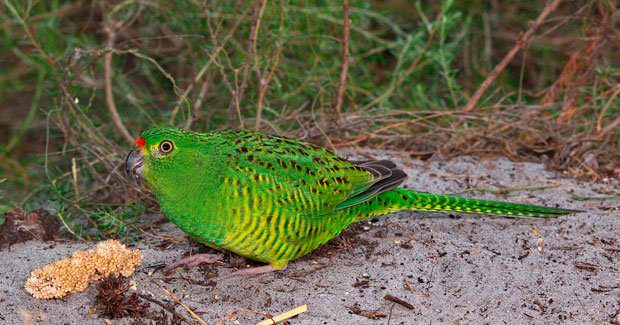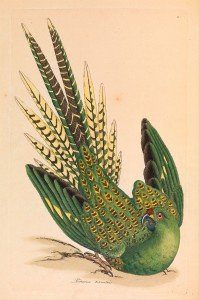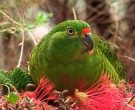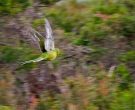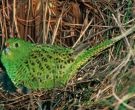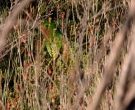Content
|
|---|
Description
30 cm. length and an approximate weight of 130 g..
The Eastern Ground Parrot (Pezoporus wallicus) has a medium-sized, It gives the impression of a slender silhouette, feeling is enhanced by the presence of a very long tail terminating beak. The identification is reinforced with rounded wings and for a few fine peaks and sharp.
The of adults they have a plumage greenish color with patterns of yellow and black as gallons or points that serve to camouflage itself.
A red band runs around the forecrown. The face and upper part of the chest They show a pretty uniform green colour. The crown Green it is abundantly stained black.
The flanks and abdomen they have yellowish clear black bars. The tail opaque green color shows yellow slots on the outer edges.
Its bill is ochre tones, with the cere rose gray. They present a periocular ring pale grey, the irises eye whitish yellow. Their legs distant have long fingers and their claws they are not curved as in the rest of the parrots.
In the females, You can see a pale yellow stripe at the bottom of the wing .
The immature they have no red frontal band, the face and the chest they have black marks. Its tail is shorter and irises of her eyes are brown.
- Sound of the Eastern Ground Parrot.
Subspecies description
-
(Kerr, 1792) – The nominal
Pezoporus wallicus wallicus
-
(Mathews, 1912) – They have black markings more prominent on the head and thicker, the neck and belly
Pezoporus wallicus leachi
Habitat:
The Eastern Ground Parrot usually live in lawns along the coast and in the neighbouring moors which rise to the 1.800 meters above sea level. Shrub-dominated moorlands that have suffered from fire in the last decade are generally considered to be their optimum habitat.. As well, moors dominated by reeds and herbs that have suffered some fire between 15 and 18 years ago, they are considered as excellent performance for these parrots. In the interior of the Moors, These birds are concentrated in the driest areas from mid autumn to late spring.
Humid areas they are frequented by the Eastern Ground Parrot, from summer to early autumn, probably in relation to the abundance of seeds at this time of the year. They can also be seen in estuaries, in boggy soils that are full of rods, in the meadows and pastures.
In Tasmania, the Eastern Ground Parrot occupies a rather special habitat consisting of a mixture or a mosaic of Heath, Sedge and weed.
As its common name indicates, These birds are reluctant to take flight. On the rare occasions when they dare to fly, its zigzag in flight seems the of a Small Sandpiper (Actitis hypoleucos) or a Woodcock (Scolopax rusticola) and develops within walking distance (a few 30 m). Once it lands, seek thick cover and can be difficult to relocate.
Contrary to what many people believe, the Eastern Ground Parrot is very active during the day, although, often, are difficult to detect, except when fleeing hastily, hearing the loud vibration of wings just before plunge among the foliage.
Son assets morning and afternoon average. At night, whatever the season, they establish the dormitories in the drylands.
These parakeets are mostly sedentary and live in couples United in a territory which is around of 9 hectares, although the area can sometimes change.
Between February and may, There is a great post-reproductive dispersion in which these birds move away some 120 kilometers from its nesting area.
Reproduction:
The Eastern Ground Parrot usually nest between jJuly and December. A litter was discovered in March. The nest is a fled surface excavated soil from 15 cm and 18 cm in width and between 2 cm and 5 depth cm; It is often full of stems or leaves. It is placed at the base of a mound or a bush above the ground which is accessed through a small tunnel..
The main plants that make up the nest, they are herbs of the genus (empodisma), plants of the genus (Xanthorrhoeoideae) and banksia sheet wide.
Of 20 nests found, 18 located in arid wastelands and 2 only in areas of transition between wetlands and land dry. In all these places there has been a fire for at least four years. The density was low, from January to March a nest each 10 hectares.
The laying includes, usually, 3 or 4 eggs, but in Tasmania (subspecies leachi), were observed 6 eggs in some nests. The incubation lasts around 20 days. Young people are altricial. When leaving the nest, at an age between 20 and 28 days, lie hidden among shrubs, just before fly.
The failure rate in the offspring is quite large, going from the 22 until 31%.
Food:
The Eastern Ground Parrot feeds primarily on seeds of a wide variety of Sedge, herbs, herbaceous plants and shrubs. Occasionally they eat green shoots, leaves, outbreaks, flowers and small fruits.
In the Great Sandy National Park (Cooloola section), the Eastern Ground Parrot feeds primarily on seeds of Sprengelia sprengelioides (Epacridaceae), Schoenus paludosus (Cyperaceae) and Restio complanatus (Restionaceae).
In the Croajingalong National Park, the diet consists, mainly, seeds or fruits of the species Cyperaceae, particularly Schoenus brevifolius and Cassytha (Lauraceae), and also unidentified species of Ericaceae and Fabaceae.
The Eastern Ground Parrot, usually, feeds on Earth, but sometimes forages among the foliage of low shrubs, or on top of clumps of planting of reeds.
The seeds take them from the soil and plants. The parakeet will remain on the stem of a plant to flatten it and throw the seeds of heads down, or it will be the peak along the stem and base of the seeds, with the intention of evicting them and that fall to the ground.
The peak used to cut the seeds and their bases, as well as to handle food. The legs are used only to flatten plant stems.
In the Bundjalung National Park, the Eastern Ground Parrot It was observed feeding on flowers. Occasionally they feed in habitats that have been modified by man, for example, one in cornfield.
They are diurnal, and actively feed throughout the day.
Distribution:
The Eastern Ground Parrot are confined in Australia. The range has contracted in recent times and the species is now only found in isolated pockets of coastal heath and reed-covered land., It extends to the South, from the South of Queensland, where a population of 3.000 birds is dispersed through of the Fraser Island and close to the continent, including Cooloola National Park, Reserve Wide Bay Military, Fraser State Forest and Great Sandy National Park.
It is common locally to around New South Wales, where they are distributed in a number of coastal sites including Evans Head, the Broadwater National Park, Byron Bay, Morton National Park, around the Howe's Cape, Barren Grounds and Nadgee nature reserve.
They come up to Victoria, in the Croajingolong National Park, and they are distributed, provided that the habitat is suitable, along the coast in a series of sites as the Wilson promontory National Park and the Discovery Bay coastal Park in the West.
In the post-breeding period, the dispersal of birds reaches areas of Gippsland and Ninety Mile Beach, Although they can also travel further including the interior Highlands.
The species has become extinct in Southern Australia and on the islands of the bass strait.
In Tasmania it is quite common in the south-west, but small flocks in the central and South-East regions, they are probably now in decline.
Subspecies distribution
-
(Kerr, 1792) – The nominal
Pezoporus wallicus wallicus
-
(Mathews, 1912) – Tasmania.
Pezoporus wallicus leachi
Conservation:
• Current category of the Red List of the UICN: Least concern
• Population trend: Decreasing
The Eastern Ground Parrot is not threatened globalmente.
Habitat loss mainly due to urban growth and modernization of agriculture, accentuated by the use of improper burning of stubble and restoration techniques of plantations of pine trees along the coast, It can be that they are endangering the species. These signs of decline are seen mostly in the West and the South of Australia.
Although the population of Tasmania probably exceed of the 100.000 specimens, the population in the South-East of the continent It is much more low and does not exceed the 3.000 Member.
"Eastern Ground Parrot" in captivity:
Take it easy, shy, active when feeds, After the sunset, enjoy bath. It is customary to their caregiver, but rarely survive beyond a few weeks.
Not found in captivity outside Australia.
Alternative names:
– Eastern Ground Parrot, Ground Parrot (Eastern) (ingles).
– Perruche terrestre (French).
– Erdsittich (German).
– Arara-de-cabeça-azul (Portuguese).
– Perico Terrestre, Perico Terrestre Oriental (español).
scientific classification:
– Order: Psittaciformes
– Family: Psittaculidae
– Genus: Pezoporus
– Scientific name: Pezoporus wallicus
– Citation: (Kerr, 1792)
– Protonimo: Psittacus wallicus
Images “Eastern Ground Parrot”:
Videos "Eastern Ground Parrot"
“Eastern Ground Parrot” (Pezoporus wallicus)
Sources:
- Avibase
- Parrots of the World – Forshaw Joseph M
- Parrots A Guide to the Parrots of the World – Tony Juniper & Mike Parr
- Birdlife
-
Photos:
(1) – To western ground parrot (Pezoporus wallicus flaviventris), one of eight in captivity. (WA Department of Environment) – australiangeographic
(2) – A Ground Parrot amongst vegetation By Jarrod Amoore [CC BY 2.0], via Wikimedia Commons
(3) – Eastern Ground Parrot – Office of Environment and Heritage
(4) – flight views of bird flushed from heath by Mat Gilfedder – lynx
(5) – By Jennene Riggs – abc
(6) – By James Sowerby (1757 – 1822) (English) (Artist, Details of artist on Google Art Project) [Public domain or Public domain], via Wikimedia Commons
- Sounds: Patrik Åberg (Xeno-canto)
